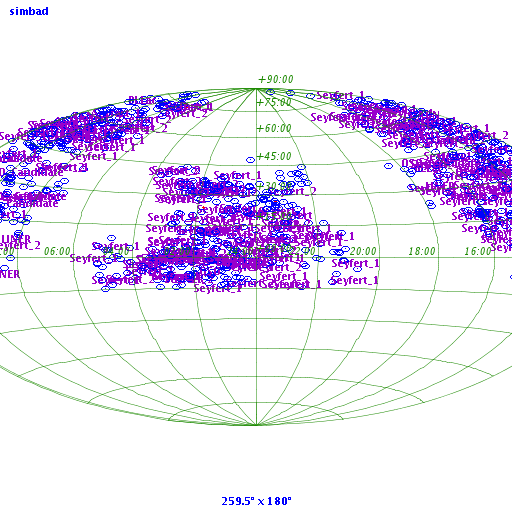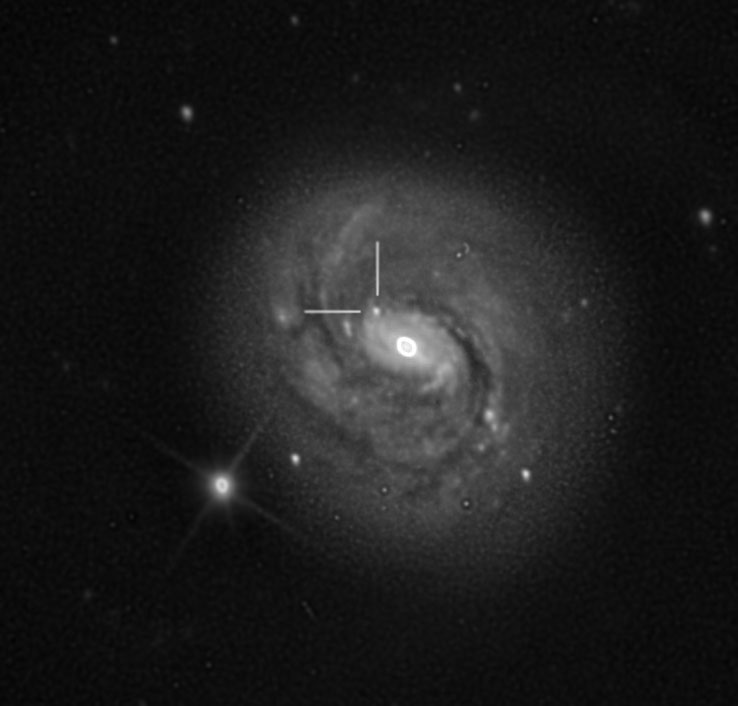|
Ionization Cone
Ionization cones are cones of ionized material extending from active galactic nuclei, predominantly observed in type II Seyfert galaxies. They are detected through their emission of electromagnetic radiation in the visible and infrared parts of the spectrum. The main method of observation is through spectroscopy, using spectral line analysis to measure the shape of the ionized region and the condition of the material such as temperature, density, composition, and degree of ionization. Characteristics Shape Ionization cones have a distinct conical shape, with the galactic center at the apex. Galaxies with ionization cones are thought to have a dense torus-like structure surrounding the central black hole, co-planar with the accretion disk. The material in this torus, consisting of interstellar gas and dust, obstructs the photons coming from the inner area around the black hole and prevents ionization of the galactic matter outside the torus. Along the symmetry axis, howe ... [...More Info...] [...Related Items...] OR: [Wikipedia] [Google] [Baidu] |
Circinus
Circinus is a small, faint constellation in the southern sky, first defined in 1756 by the French astronomer Nicolas-Louis de Lacaille. Its name is Latin for compass (drawing tool), compass, referring to the Technical drawing, drafting tool used for drawing circles (it should not be confused with Pyxis, a constellation that represents a mariner's compass which points north). Its brightest star is Alpha Circini, with an apparent magnitude of 3.19. Slightly variable star, variable, it is the brightest rapidly oscillating Ap star in the night sky. AX Circini is a Cepheid variable visible with the unaided eye, and BX Circini is a faint star thought to have been formed from the merger of two white dwarfs. Two sun-like stars have planetary systems: HD 134060 has two small planets, and HD 129445 has a Jupiter-like planet. Supernova SN 185 appeared in Circinus in 185 AD and was recorded by Chinese observers. Two novae have been observed more recently, in the 20th century. The Milky ... [...More Info...] [...Related Items...] OR: [Wikipedia] [Google] [Baidu] |
Galactic Plane
The galactic plane is the plane on which the majority of a disk-shaped galaxy's mass lies. The directions perpendicular to the galactic plane point to the galactic poles. In actual usage, the terms ''galactic plane'' and ''galactic poles'' usually refer specifically to the plane and poles of the Milky Way, in which Planet Earth is located. Some galaxies are irregular and do not have any well-defined disk. Even in the case of a barred spiral galaxy like the Milky Way, defining the galactic plane is slightly imprecise and arbitrary since the stars are not perfectly coplanar. In 1959, the IAU defined the position of the Milky Way's north galactic pole as exactly RA = , Dec = in the then-used B1950 epoch; in the currently-used J2000 epoch, after precession is taken into account, its position is RA , Dec . This position is in Coma Berenices, near the bright star Arcturus; likewise, the south galactic pole lies in the constellation Sculptor. The "zero of longitude" of galactic coor ... [...More Info...] [...Related Items...] OR: [Wikipedia] [Google] [Baidu] |
Radiation
In physics, radiation is the emission or transmission of energy in the form of waves or particles through space or through a material medium. This includes: * ''electromagnetic radiation'', such as radio waves, microwaves, infrared, visible light, ultraviolet, x-rays, and gamma radiation (γ) * ''particle radiation'', such as alpha radiation (α), beta radiation (β), proton radiation and neutron radiation (particles of non-zero rest energy) * '' acoustic radiation'', such as ultrasound, sound, and seismic waves (dependent on a physical transmission medium) * ''gravitational wave, gravitational radiation'', that takes the form of gravitational waves, or ripples in the curvature of spacetime Radiation is often categorized as either ''ionizing radiation, ionizing'' or ''non-ionizing radiation, non-ionizing'' depending on the energy of the radiated particles. Ionizing radiation carries more than 10 electron volt, eV, which is enough to ionize atoms and molecules and break ... [...More Info...] [...Related Items...] OR: [Wikipedia] [Google] [Baidu] |
X-ray
An X-ray, or, much less commonly, X-radiation, is a penetrating form of high-energy electromagnetic radiation. Most X-rays have a wavelength ranging from 10 picometers to 10 nanometers, corresponding to frequencies in the range 30 petahertz to 30 exahertz ( to ) and energies in the range 145 eV to 124 keV. X-ray wavelengths are shorter than those of UV rays and typically longer than those of gamma rays. In many languages, X-radiation is referred to as Röntgen radiation, after the German scientist Wilhelm Conrad Röntgen, who discovered it on November 8, 1895. He named it ''X-radiation'' to signify an unknown type of radiation.Novelline, Robert (1997). ''Squire's Fundamentals of Radiology''. Harvard University Press. 5th edition. . Spellings of ''X-ray(s)'' in English include the variants ''x-ray(s)'', ''xray(s)'', and ''X ray(s)''. The most familiar use of X-rays is checking for fractures (broken bones), but X-rays are also used in other ways. ... [...More Info...] [...Related Items...] OR: [Wikipedia] [Google] [Baidu] |
Interstellar Medium
In astronomy, the interstellar medium is the matter and radiation that exist in the space between the star systems in a galaxy. This matter includes gas in ionic, atomic, and molecular form, as well as dust and cosmic rays. It fills interstellar space and blends smoothly into the surrounding intergalactic space. The energy that occupies the same volume, in the form of electromagnetic radiation, is the interstellar radiation field. The interstellar medium is composed of multiple phases distinguished by whether matter is ionic, atomic, or molecular, and the temperature and density of the matter. The interstellar medium is composed, primarily, of hydrogen, followed by helium with trace amounts of carbon, oxygen, and nitrogen. The thermal pressures of these phases are in rough equilibrium with one another. Magnetic fields and turbulent motions also provide pressure in the ISM, and are typically more important, dynamically, than the thermal pressure is. In the interstellar medium, ... [...More Info...] [...Related Items...] OR: [Wikipedia] [Google] [Baidu] |
Markarian Galaxies
The Markarian galaxies are a class of galaxies that have nuclei with excessive amounts of ultraviolet emissions compared with other galaxies. Benjamin Markarian drew attention to these types of galaxies starting in 1963. The nuclei of the galaxies had a blue colour, associated to stars in the classes from O to A. This blue core did not match the rest of the galaxy. The spectrum in detail tends to show a continuum that Markarian concluded was produced non- thermally. Most of these have emission lines and are characterized by highly energetic activity. Markarian Catalogue entries are of the form "Markarian ####", and can frequently use the abbreviations Mrk, Mkr, Mkn; and rarely Ma, Mk, Mark. History In 1964 Markarian decided to search for this kind of galaxy. The First Byurakan Survey commenced in 1965 using the Schmidt telescope at the Byurakan Astrophysical Observatory in Armenian SSR. The telescope used a 132 cm mirror and 102 cm correcting plate. When this st ... [...More Info...] [...Related Items...] OR: [Wikipedia] [Google] [Baidu] |
Plasma (physics)
Plasma () 1, where \nu_ is the electron gyrofrequency and \nu_ is the electron collision rate. It is often the case that the electrons are magnetized while the ions are not. Magnetized plasmas are ''anisotropic'', meaning that their properties in the direction parallel to the magnetic field are different from those perpendicular to it. While electric fields in plasmas are usually small due to the plasma high conductivity, the electric field associated with a plasma moving with velocity \mathbf in the magnetic field \mathbf is given by the usual Lorentz force, Lorentz formula \mathbf = -\mathbf\times\mathbf, and is not affected by Debye shielding. Mathematical descriptions To completely describe the state of a plasma, all of the particle locations and velocities that describe the electromagnetic field in the plasma region would need to be written down. However, it is generally not practical or necessary to keep track of all the particles in a plasma. Therefore, plasma physicist ... [...More Info...] [...Related Items...] OR: [Wikipedia] [Google] [Baidu] |
Chandra X-ray Observatory
The Chandra X-ray Observatory (CXO), previously known as the Advanced X-ray Astrophysics Facility (AXAF), is a Flagship-class space telescope launched aboard the during STS-93 by NASA on July 23, 1999. Chandra is sensitive to X-ray sources 100 times fainter than any previous X-ray telescope, enabled by the high angular resolution of its mirrors. Since the Earth's atmosphere absorbs the vast majority of X-rays, they are not detectable from Earth-based telescopes; therefore space-based telescopes are required to make these observations. Chandra is an Earth satellite in a 64-hour orbit, and its mission is ongoing . Chandra is one of the Great Observatories, along with the Hubble Space Telescope, Compton Gamma Ray Observatory (1991–2000), and the Spitzer Space Telescope (2003–2020). The telescope is named after the Nobel Prize-winning Indian-American astrophysicist Subrahmanyan Chandrasekhar. Its mission is similar to that of ESA's XMM-Newton spacecraft, also launched in ... [...More Info...] [...Related Items...] OR: [Wikipedia] [Google] [Baidu] |
Messier 77
Messier 77 or M77, also known as NGC 1068 and the Squid Galaxy, is a barred spiral galaxy about 47 million light-years away in the constellation Cetus. Messier 77 was discovered by Pierre Méchain in 1780, who originally described it as a nebula. Méchain then communicated his discovery to Charles Messier, who subsequently listed the object in his catalog. Both Messier and William Herschel described this galaxy as a star cluster. Today, however, the object is known to be a galaxy. The morphological classification of NGC 1068 in the De Vaucouleurs system is (R)SA(rs)b, where the '(R)' indicates an outer ring-like structure, 'SA' denotes a non-barred spiral, '(rs)' means a transitional inner ring/spiral structure, and 'b' says the spiral arms are moderately wound. Ann et al. (2015) gave it a class of SAa, suggesting tightly wound arms. However, infrared images of the inner part of the galaxy reveal a prominent bar not seen in visual light, and for this reason it is now conside ... [...More Info...] [...Related Items...] OR: [Wikipedia] [Google] [Baidu] |
NGC 5728
NGC 5728 is an active barred spiral galaxy located 146 million light years away in the southern constellation of Libra. It was discovered on May 7, 1787 by William Herschel. The designation comes from the ''New General Catalogue'' of J. L. E. Dreyer, published in 1888. It has an apparent visual magnitude of 13.40 and spans an angle of . The galaxy shows a red shift of 0.00935 and has a heliocentric radial velocity of 2,803 km/s. It has an estimated mass of 72 billion times the mass of the Sun and stretches around across. The morphological classification of this galaxy is SAB(r)a?, which indicates a weakly barred spiral galaxy (SAB) with a ring-like structure (r) and possible tightly wound arms (a?). The Spitzer galactic survey lists a morphology code of (R1)SB(l,bl,nr,nb)0/a, meaning a barred spiral having a closer outer ring and an inner pseudo-ring/lens, plus a nuclear ring and bar/bar-lens. Vera Rubin described it as having a "distinct elliptical structure ... [...More Info...] [...Related Items...] OR: [Wikipedia] [Google] [Baidu] |
Light-year
A light-year, alternatively spelled light year, is a large unit of length used to express astronomical distances and is equivalent to about 9.46 trillion kilometers (), or 5.88 trillion miles ().One trillion here is taken to be 1012 (one million million, or billion in long scale). As defined by the International Astronomical Union (IAU), a light-year is the distance that light travels in a vacuum in one Julian year (365.25 days). Because it includes the time-measurement word "year", the term ''light-year'' is sometimes misinterpreted as a unit of time. The ''light-year'' is most often used when expressing distances to stars and other distances on a galactic scale, especially in non-specialist contexts and popular science publications. The unit most commonly used in professional astronomy is the parsec (symbol: pc, about 3.26 light-years) which derives from astrometry; it is the distance at which one astronomical unit subtends an angle of one second of arc. Defini ... [...More Info...] [...Related Items...] OR: [Wikipedia] [Google] [Baidu] |
Parsec
The parsec (symbol: pc) is a unit of length used to measure the large distances to astronomical objects outside the Solar System, approximately equal to or (au), i.e. . The parsec unit is obtained by the use of parallax and trigonometry, and is defined as the distance at which 1 au subtends an angle of one arcsecond ( of a degree). This corresponds to astronomical units, i.e. 1\, \mathrm = 1/\tan \left( \ \mathrm \right)\, \mathrm. The nearest star, Proxima Centauri, is about from the Sun. Most stars visible to the naked eye are within a few hundred parsecs of the Sun, with the most distant at a few thousand. The word ''parsec'' is a portmanteau of "parallax of one second" and was coined by the British astronomer Herbert Hall Turner in 1913 to make calculations of astronomical distances from only raw observational data easy for astronomers. Partly for this reason, it is the unit preferred in astronomy and astrophysics, though the light-year remains prominent in popular s ... [...More Info...] [...Related Items...] OR: [Wikipedia] [Google] [Baidu] |








